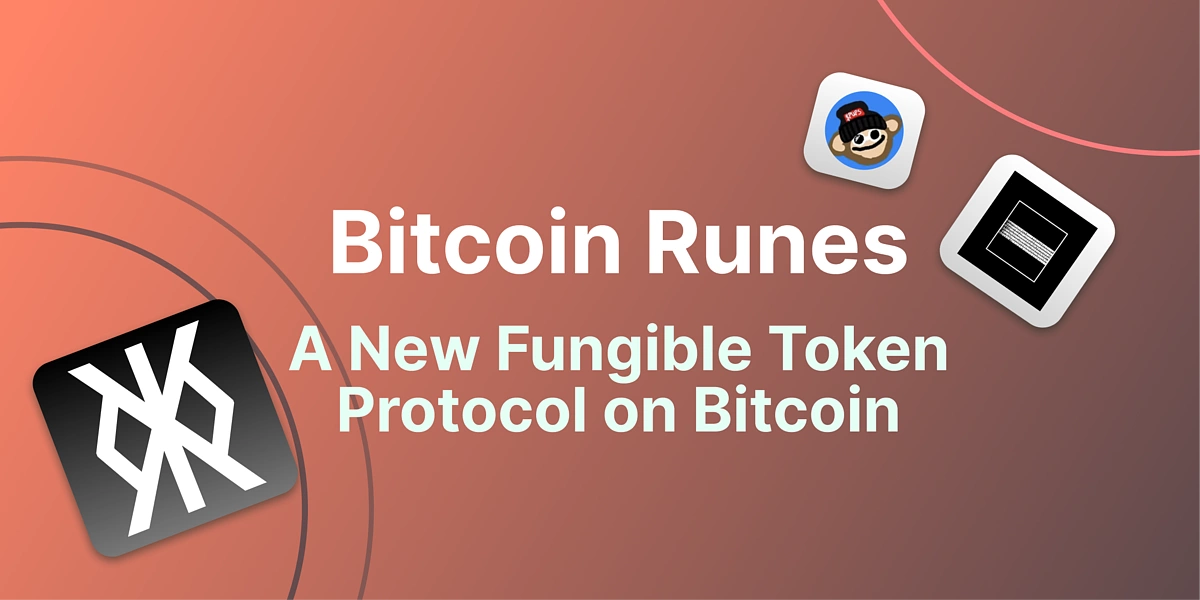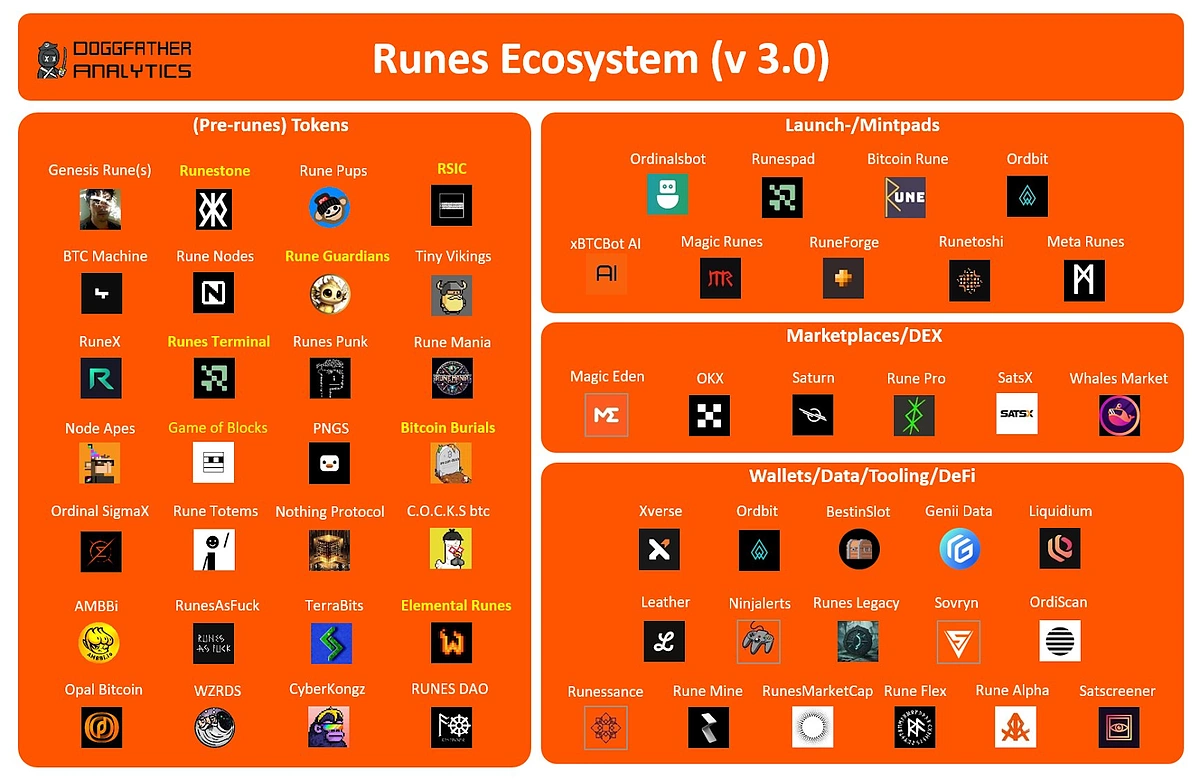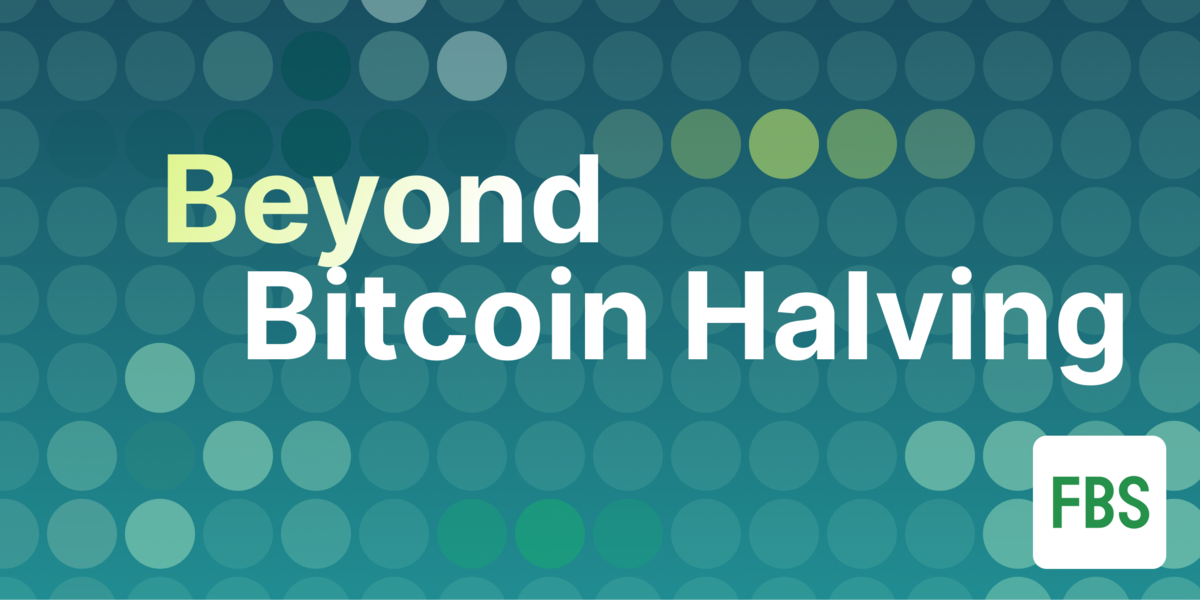What Are Runes on Bitcoin?
Runes is a new token standard on Bitcoin that makes it easier and more efficient for users to create fungible tokens on the blockchain.
Key Takeaways
-
Runes is a new protocol to create fungible tokens on the Bitcoin blockchain.
-
By using Bitcoin’s UTXO model and the OP_RETURN opcode, Runes will simplify the creation and management of fungible tokens.
-
Runes will improve Bitcoin’s efficiency around fungible tokens, while expanding the Bitcoin network’s utility to appeal to a wider audience by making it easier to create meme coins and other community-driven projects on the blockchain.
-
At time of writing, the most popular Rune by market cap is RSIC•GENESIS•RUNE, with a market cap of over $325 million.

Over the past two years, the Bitcoin ecosystem has evolved to include fungible and non-fungible tokens on the Bitcoin network. These tokens have already reached a market cap of over $2 billion and generated hundreds of millions in revenue for miners on the network. With the release of Runes, a token protocol that will revolutionize the creation of tokens on Bitcoin, there is plenty of anticipation around what it’ll bring to the Bitcoin ecosystem – like meme coins.
Runes was released following the fourth Bitcoin halving, which took place on 20 April 2024. Following its launch, the Rune with the largest marketcap at time of writing is RSIC (RSIC•GENESIS•RUNE) at over $325 million based on OKX data. The launch of Runes also sent Bitcoin transaction fees soaring to new heights on the day of launch on 20 April, with average transaction fees reaching over $127.
 Source: BitInfoCharts
Source: BitInfoChartsUnderstanding Bitcoin Runes
Casey Rodarmor, the creator of the Ordinals protocol that lets users create NFT-like inscriptions on the Bitcoin blockchain, is releasing Runes, a new protocol that lets users easily create tokens on top of Bitcoin like Solana and Ethereum. While the BRC-20 and SRC-20 token standards already exist, these are based on Ordinals theory, which can result in UTXO proliferation that spam Bitcoin,
In an attempt to create a healthier way of etching tokens on the Bitcoin network, Rodarmor announced Runes in September 2023 and has been working on this since then. As the protocol nears its launch date, there is an increase in interest around Runes and what it could mean for Bitcoin.
“Creating a good fungible token protocol for Bitcoin might bring significant transaction fee revenue, developer mindshare, and users to Bitcoin.”
- Casey Rodarmor, creator of Runes
Bitcoin Runes launchedon Block 840,000, following the Bitcoin halving in April 2024. The creator does not impact Bitcoin, although it adds to the excitement that follows the fourth Bitcoin halving. Rodarmor states that Bitcoin Runes’ simplicity and overall architecture will aid the primary reason for its development – the creation of fungible tokens on the Bitcoin blockchain.
There is plenty of anticipation around Runes, with Franklin Templeton stating:
“Currently the fungible token market for Bitcoin is quite small in comparison to ETH and SOL; however, with the launch of more efficient token standard (Runes), Bitcoin is positioned well to to close the gap between its fungible market cap versus that of other blockchains.”
Bitcoin Runes are tokens created on the Bitcoin blockchain. They are a set of executable data that allows specified assets to be created and spent on the network. Just like BRC-20 and SRC-20 tokens, Runes rely on the Bitcoin blockchain to operate, however, Runes are designed to be simpler, not dependent on Ordinals, and are healthier and more efficient than both other token standards and adopts key (existing) models of the Bitcoin blockchain like the UTXO model and the OP_RETURN opcode. Moreover, unlike other existing fungible token protocols on Bitcoin, Runes will not rely on off-chain data as in the case of RGB and Taprot Assets, and doesn’t require a native token for operations like Omni Layer and Counterparty.
Runes in the Bitcoin Ecosystem
Runes also works with existing Bitcoin infrastructure; it is compatible with the Lightning Network, a Bitcoin Layer 2 which offers users faster and cheaper transactions, potentially giving Runes an advantage over other fungible token protocols on Bitcoin while enhacing Bitcoin's capabilities for handling fungible tokens on its network. As each Runestone corresponds to a UTXO, where UTXOs can be locked in Hashed Time-Locked Contracts, this means Runes can be easily integrated with the Lightning Network.
Runes were built for degens and memecoins, but the protocol is simple, efficient, and secure. It is a legitimate competitor to Taproot Assets and RGB.
— Casey (@rodarmor) April 1, 2024
The protocol is self contained and has no dependencies on ordinals or inscriptions, making it extremely simple.
Balances are…
Now let's take a closer look at how Bitcoin Runes work;
How Bitcoin Runes Work
Two terms are essential to understanding how the Bitcoin Runes protocol works;
-
Bitcoin’s UTXO transaction model
-
The OP_RETURN opcode
In a UTXO (Unspent Transaction Output) transaction model, the total asset held in a user’s ledger is consumed for each transaction, where the algorithm computes the new balance after transferring the intended amount of tokens to the recipient. Each UTXO can hold any amount of any number of Runes.
The OP_RETURN opcode enables users to attach extra information to Bitcoin transactions without affecting the spendability of UTXOs, ensuring no impact the network’s efficiency while minimizing blockchain bloat. In the case of Runes, the OP_RETURN function is used for data storage and the specifics around transaction handling. The OP_RETURN opcode enables Bitcoin users to add up to 80 bytes of data to an unspendable transaction. This data includes information about the token, including the name, ID, symbol, command for specific actions and other required data. Runes protocol messages stored in the OP_RETURN area of a Bitcoin transaction can also be referred to as the Runestone.
Compared to the existing BRC-20 standard, which only lets users transfer one token type per transaction, Runes lets users transfer any number of Runes where each Rune transaction can specify multiple operations across different Runes. In the event of a token transfer, the Runes protocol will split the UTXO into multiple new UTXOs based on the instructions in the OP_RETURN data. Each UTXO represents different amounts of the token, which are then sent off to their recipients.
If a Rune transaction fails due an invalid protocol message, the Runes will be burned to prevent any accidental creation of Runes.
Etching and Minting Runes on Bitcoin
The process of creating a new Rune is known as Etching. Users who wish to etch a new Rune specify the name, symbol, ID, supply amount, divisibility, and parameters related to the generation and distribution of the Rune in the OP_RETURN output. Creators can also include a “premine” in the etching process, where a set amount of the Rune is allocated to the creator before it’s available to the general public.
After etching, Runes can be minted through open or closed mints. Open minting allows anyone to mint a Rune after the initial etching, where anyone can create a mint transaction to mint a fixed amount of new Runes. Closed mints only allow the creation of new tokens when predetermined conditions are met, such as a specific time period, after which the minting process is ended, capping the token supply.
Edicts define how Runes can be transferred after etching or minting. Using the edict function, batch rune transfers, airdrop and transfer of all minted Rune to a single account can be performed.
Possible Symbol Squatting on Bitcoin Runes
The Runes protocol will not regulate symbol squatting to keep the protocol simple. This means that squatters can hold onto desirable symbols, which can be of any length utilizing the alphabet (A-Z). Rodarmor suggests solutions like only allowing assignments of symbols above a certain length upon launch, with the length decreasing over time, and based on information available on Ordiscan, the first three-character rune will only be available about three years later.
Benefits of Bitcoin Runes
Runes aim to simplify fungible token creation on the Bitcoin blockchain, along with other goals like minimizing on-chain footprint and improving UTXO management. Let’s take a closer look at some of the benefits Runes will bring to users and the Bitcoin network.
Simplicity
Bitcoin Runes are expected to offer users a simpler way of creating fungible tokens on the Bitcoin network, relative to other alternatives like BRC-20, RGB, and Taproot. With Runes, users can create multiple tokens and manage them easily on-chain, without needing to rely on off-chain data or native tokens, or generating a significant amount of “junk” UTXOs.
Resource Efficiency
BRC-20 is described as an expensive way of creating and managing tokens on Bitcoin. This is thanks to its mode of operation which results in the proliferation of UTXOs. Bitcoin currently battles an influx of UTXOs that will never be spent. This piles on the network, causing performance issues. Bitcoin Rune avoids this due to its design. The OP-RETURN model doesn’t create UTXOs that cannot be spent and the storage parameters consume lesser resources. The OP_RETURN opcode is only 80 bytes compared to BRC-20 inscriptions with memory capacity of up to 4MB; this makes more economical use of the Bitcoin network’s resources.
Integration With Bitcoin’s UTXO Model
The UTXO model is Bitcoin’s way of managing user assets. According to Rodarmor, Bitcoin Runes inherit this design as well. This complements the Bitcoin blockchain and makes Bitcoin Runes viable for UTXO-based facilities. The spending model of Bitcoin Runes sets it apart from standards like BRC-20 and SRC-20.
Increase in Miner Revenue
After April's Bitcoin Halving, miners are now earning 3.125 bitcoins. With this reduction in miner revenue, Runes potentially offers Bitcoin miners another source of revenue. After all, data space in new Bitcoin blocks are limited, so the more transactions miners have to process for the network, the higher the transaction fees.
Expanded User Base
The primary utility of Bitcoin Runes according to the protocol’s creator is ‘fun and meme coins’. Meme coins are a novel community-building strategy and have drawn interest from crypto natives and mainstream investors. Ordinals and BRC-20 have enabled the creation of fungible tokens used as meme coins and attracted a significant number of new users to the Bitcoin network.
Bitcoin Runes have already gained the attention of meme coin communities, as meme coin projects dominate the pre-launch project list. Pending the official launch, the Bitcoin network could welcome a new set of users looking to trade these meme coins. The expanding user base and increased network usage will also grow the revenue system of the network and incentivize more miners to join the network.
Expanded Utility for the Bitcoin Network
The different protocols that enable the creation of tokens on the Bitcoin blockchain create an additional utility for the network. As Rune projects bring their individual strategies to the network, the Bitcoin network’s application broadens. The expansion will be determined by the innovative abilities of these projects.
The Bitcoin Runes Ecosystem

New projects are set to launch in the ecosystem while some existing projects have shared plans to branch into the Runes ecosystem when the protocol goes live. Some of these projects will interact directly with the protocol to create assets on the Bitcoin blockchain while others will offer utilities to Bitcoin Runes enthusiasts. Here are some of the different types of projects that will be joining the Bitcoin Runes ecosystem.
Tokens
Fungible token projects looking to etch a rune into the Bitcoin network using the Bitcoin Runes protocol include Rune Pups, Runevo, Runestone, and RSIC. At the moment, most of these are NFTs that are earning the respective Runes for their holders until the Runes protocol goes live. In the case of Runestones, three meme coins will be airdropped to every Runestones holder.
Launchpad
Bitcoin Runes launchpads will offer Rune projects a platform to kick-start their journey. One of these launchpads is Bitcoin Rune, which gives users a glimpse of what platforms like these could offer for Bitcoin Rune projects. While still in the testnet phase, Bitcoin Rune will enable projects to etch runes and run diverse operations including Rune transfers. Bitcoin Rune will also feature a marketplace where newly launched and existing Bitcoin Rune projects can start trading.
Marketplace
Certain marketplaces will support Bitcoin Runes, allowing users to list and trade them on their platforms. OKX has a marketplace for trading Runes, where users can list and buy Runes including RSIC and SATOSHI•NAKAMOTO. NFT platform Magic Eden has also launched a section for Bitcoin Runes, including a pre-rune section for yet-to-launch Bitcoin Rune projects. Whales Market, a pre-market platform offers users a pre-launch platform where users can trade their TGE (Token Generation Event) allocations of Bitcoin Rune projects.
Wallets
While Bitcoin Runes are minted on the Bitcoin blockchain, they require specific wallet applications for asset management. Users can use wallets like Xverse, which also supports BRC-20 tokens, to manage their Bitcoin Runes.
Bitcoin Runes vs. BRC-20
Like BRC-20, the Runes protocol enables the creation of tokens on the Bitcoin blockchain. BRC-20 uses the Ordinals protocol – a technology that allows data to be attached to a Bitcoin sat. Bitcoin Rune was introduced as an improvement to this design, as it is less demanding on the Bitcoin network’s resources. Key differences exist between both designs in areas such as asset creation, routine operation, and adoption. BRC-20 tokens have a first-mover advantage and have seen significant adoption. Here’s a summary of the difference between BRC-20 and Bitcoin rune
|
|
Bitcoin Runes |
BRC-20 |
|
Operation Model |
Based on Bitcoin’s UTXO model |
Based on the Bitcoin Ordinals |
|
Data Storage |
Data is stored in the OP_RETURN field |
Data is inscribed on a sat. |
|
Token Minting |
Runes can be minted via open and closed minting procedures, and premining is available. |
BRC-20 minting is limited to the open minting procedure. |
|
Token Transfers |
Transfers create a new set of UTXOs based on OP_RETURN data. |
Transfers require new inscriptions. |
|
Management |
Compatible with the Bitcoin Lightning network and supports lightning clients and SPV (Simplified Payment Verification) wallets. |
Requires Ordinals-supported wallets. |
|
Creator |
Casey Rodarmor |
Domo |
Final Thoughts
With Bitcoin Runes, the Bitcoin network gains another token-issuance mechanism. While the network wasn’t designed for this originally, it is refreshing to see more fun coming to the oldest model of modern blockchains. Warming up to the launch, many projects are already building up communities in readiness for their individual launches. The model described for Bitcoin Runes is quite interesting as it leverages some older attributes of the network to deliver what might be another significant addition to the whole space. As the excitement grows, the Bitcoin network sees even more usage and adoption. It is uncertain what impression this makes to mainstream investors, however, for native crypto enthusiasts, more use cases for the Bitcoin network wouldn’t hurt.
Having said this, it is important to keep in mind that Bitcoin Runes is at its earliest stage of development, and like any other new introduction, it is prone to key changes and fluctuation in performance. Projects launching using this technology and joining the Bitcoin Rune ecosystem are also highly speculative at time of writing. Always do your own research before investing in any cryptocurrency. Also, note that this article only discusses Bitcoin Runes on technological grounds. It is only meant for educational purposes and should not be taken as financial advice. Featured projects are not endorsed.

Joel is deeply interested in the technologies behind cryptocurrencies and blockchain networks. In his over 7 years of involvement in the space, he helps startups build a stronger internet presence through written content. Follow the author on Twitter @agboifesinachi









 Or check it out in the app stores
Or check it out in the app stores